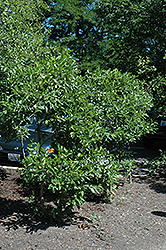It's all about ...
plants

Height: 15 feet
Spread: 15 feet
Sunlight:
![]()
![]()
Hardiness Zone: 5a
Other Names: Beach Alder
Description:
A tough North American native that forms shrubby thickets in time, good for naturalizing an area, tolerant of ocean spray and wet conditions so ideal for seaside plantings
Ornamental Features
Seaside Alder features subtle tan catkins hanging below the branches in early fall. It has dark green deciduous foliage. The glossy narrow leaves do not develop any appreciable fall colour.
Landscape Attributes
Seaside Alder is a multi-stemmed deciduous shrub with a more or less rounded form. Its average texture blends into the landscape, but can be balanced by one or two finer or coarser trees or shrubs for an effective composition.
This shrub will require occasional maintenance and upkeep, and is best pruned in late winter once the threat of extreme cold has passed. Gardeners should be aware of the following characteristic(s) that may warrant special consideration;
- Spreading
Seaside Alder is recommended for the following landscape applications;
- Mass Planting
- Naturalizing And Woodland Gardens
Planting & Growing
Seaside Alder will grow to be about 15 feet tall at maturity, with a spread of 15 feet. It has a low canopy with a typical clearance of 2 feet from the ground, and is suitable for planting under power lines. It grows at a fast rate, and under ideal conditions can be expected to live for 40 years or more.
This shrub does best in full sun to partial shade. It is quite adaptable, prefering to grow in average to wet conditions, and will even tolerate some standing water. It is not particular as to soil type or pH, and is able to handle environmental salt. It is highly tolerant of urban pollution and will even thrive in inner city environments. This species is native to parts of North America.
This plant is not reliably hardy in our region, and certain restrictions may apply; contact the store for more information.
